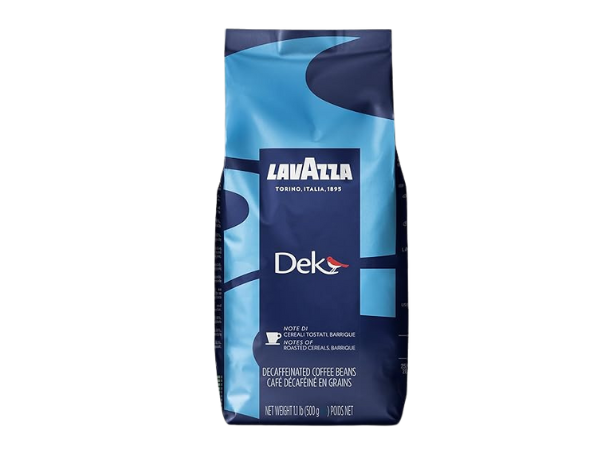
Lavazza Dek
Caffeine
5–7 mg
Note: Caffeine amounts are based on standard brewing methods using Lavazza Dek ground coffee. Actual caffeine content may vary depending on preparation style (espresso, drip, moka pot), grind size, and water temperature.
| Attribute | Value |
|---|---|
| Caffeine Level | Very Low |
| Serving Size | 6 – 8 fl oz |
| Serving Size (ml) | 180 – 240 ml |
| Caffeine | 5–7 mg |
| Calories | 2 kcal |
| Sugar | 0 g |
| Caffeine per fl oz | 0.8–1 mg/fl oz |
Lavazza Dek is a popular decaffeinated coffee blend known for its smooth flavor and Italian craftsmanship. While it’s marketed as a decaf option, many coffee lovers are curious about how much caffeine it actually contains.
What Is Lavazza Dek?
Lavazza Dek is Lavazza’s signature decaffeinated coffee blend, crafted for those who want to enjoy the taste of coffee without the full caffeine kick. It’s made from a mix of Arabica and Robusta beans sourced primarily from South America.
Here’s what defines Lavazza Dek:
- Blend Composition – A balanced mix of Brazilian Arabica and natural Robusta beans.
- Roast Level – Medium roast, offering a smooth yet full-bodied experience.
- Decaffeination Method – Uses a natural carbon dioxide (CO₂) process, which avoids chemical solvents.
- Available Formats – Sold as whole beans, pre-ground coffee, and ESE pods.
- Target Audience – Ideal for health-conscious coffee drinkers or those sensitive to caffeine.
Lavazza Dek is designed to deliver the essence of Italian espresso culture while minimizing caffeine intake. It’s a go-to choice for those who want to enjoy coffee any time of day without disrupting their sleep or overstimulating their system.
Flavor Profile and Roast Level of Lavazza Dek
Despite being decaffeinated, Lavazza Dek doesn’t compromise on flavor. It’s crafted to retain the aromatic complexity and richness that coffee lovers crave.
Here’s what you can expect from its flavor and roast:
- Aromatic Notes – Fruity, winey, and roasted cereal tones dominate the cup.
- Body – Medium-bodied with a velvety mouthfeel.
- Acidity – Mild acidity that complements the sweetness of the blend.
- Roast Profile – Medium roast, which balances brightness and depth.
- Aftertaste – Clean and lingering, with subtle nutty undertones.
The medium roast enhances the natural flavors of the beans without overpowering them, making Lavazza Dek a versatile option for espresso, moka pot, or drip brewing. It’s a testament to Lavazza’s expertise in preserving flavor even in decaffeinated blends.
Is Lavazza Dek Truly Decaffeinated?
While Lavazza Dek is labeled as decaffeinated, it’s important to understand that “decaf” doesn’t mean caffeine-free. The CO₂ decaffeination process used by Lavazza is one of the most natural and health-conscious methods available, but it still leaves trace amounts of caffeine.
Key facts about its decaffeination:
- Method Used – Carbon dioxide (CO₂) extraction, which avoids chemical solvents.
- Caffeine Residual – Typically contains 2–7 mg of caffeine per 8 oz cup.
- Health Benefits – Lower caffeine content reduces risk of jitteriness and sleep disruption.
- Preserved Flavor – The CO₂ method retains more of the bean’s natural oils and flavors.
- Regulatory Standards – Meets EU and US standards for decaffeinated coffee (97%+ caffeine removed).
So yes, Lavazza Dek is truly decaffeinated by industry standards, though not entirely caffeine-free. It’s a great option for those looking to cut back on caffeine without sacrificing taste.
Caffeine Content by Serving Size
Understanding how much caffeine is in a typical serving of Lavazza Dek helps consumers make informed choices. While the exact amount can vary slightly depending on brewing method and strength, here’s a general breakdown:
- 1 Espresso Shot (30 ml) – 2–3 mg of caffeine
- 1 Cup (8 oz / 240 ml) – 5–7 mg of caffeine
- Double Espresso (60 ml) – 4–6 mg of caffeine
- Moka Pot (per 100 ml) – 6–8 mg of caffeine
- French Press (per 8 oz cup) – 5–8 mg of caffeine
These values are significantly lower than regular coffee, which can contain 70–140 mg per 8 oz cup. Lavazza Dek allows you to enjoy multiple cups a day without exceeding your caffeine limit.
Caffeine in Lavazza Dek per Gram
If you prefer to measure your coffee by weight, it’s helpful to know how much caffeine is in each gram of Lavazza Dek. This is especially useful for home brewers and baristas who weigh their coffee for precision.
Here’s the estimated caffeine content per gram:
- Caffeine per Gram (Dry Coffee) – 1.2–1.5 mg
- Standard Espresso Dose (7 g) – 8–10 mg total caffeine
- Standard Filter Coffee Dose (15 g) – 18–22 mg total caffeine
- Compared to Regular Coffee – Regular beans contain 10–12 mg caffeine per gram
- Caffeine Reduction – Lavazza Dek has 85–90% less caffeine than regular beans
These numbers show that Lavazza Dek is a true decaf option, offering just a fraction of the caffeine found in standard coffee beans. It’s ideal for those who want to moderate their intake without giving up their daily brew.
Caffeine Levels per Can or Package
Lavazza Dek is sold in various formats, including 250 g and 500 g bags of whole beans or ground coffee. While the packaging doesn’t list total caffeine content, we can estimate based on average caffeine per gram.
Here’s a breakdown by package size:
- 250 g Bag – 300–375 mg total caffeine
- 500 g Bag – 600–750 mg total caffeine
- ESE Pods (7 g each) – 8–10 mg caffeine per pod
- Serving Yield (250 g) – 35 cups (7 g per cup)
- Serving Yield (500 g) – 70 cups (7 g per cup)
These estimates help you plan your consumption and understand how long a package might last. Even with regular use, the total caffeine intake from Lavazza Dek remains low and manageable.
